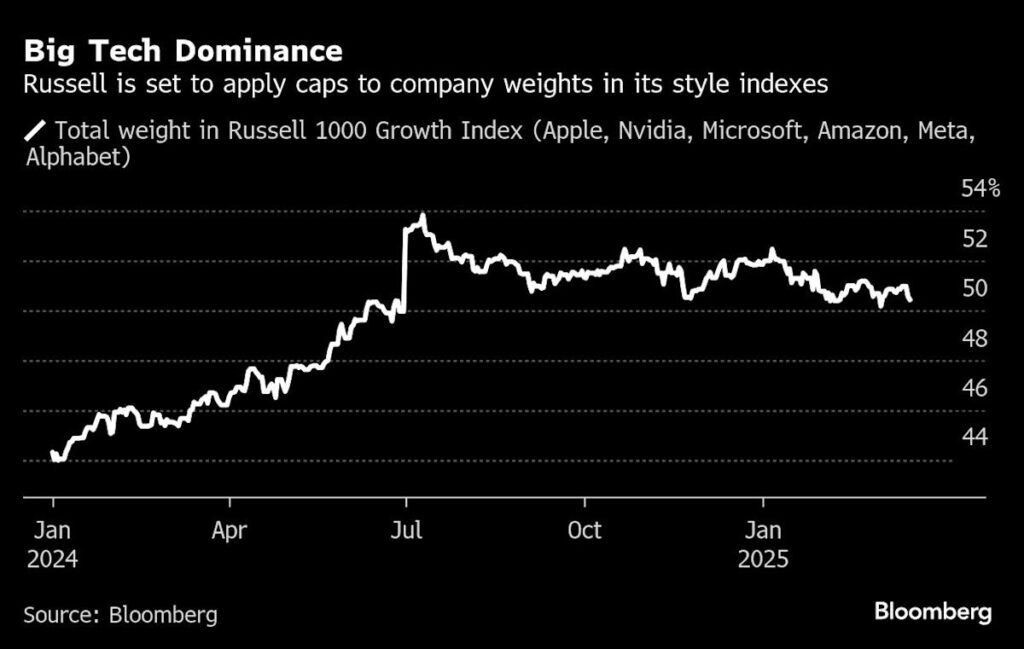(Bloomberg) — For index behemoth FTSE Russell, the likes of Apple Inc. are still too big for comfort — even after the recent $2 trillion selloff that’s dethroned Big Tech from the stock market’s leaderboard.
Most Read from Bloomberg
After equity trading wraps up on Friday, shares of the iPhone maker and five other technology giants will see their weightings shrink, with the benchmark provider pushing ahead with plans to curb the group’s influence in key US growth and value gauges.
Together, the reduction is poised to prompt almost $6 billion of share selling from index-tracking funds following the Russell 1000 Growth gauge (ticker RLG), according to an analysis by JPMorgan Chase & Co. analysts Min Moon and Vivek Shah.
While the projected outflow is modest, the sheer fact that the technology megacaps are still getting their wings clipped underscores their extreme outperformance for more than a decade. At the peak in July, the cohort comprised 54% of RLG. Now, even after their market slump, the group still makes up half of the index.
Russell is the latest index overlord compelled to adapt to the modern investing era, where megacap stocks have reigned like never before. The lopsided market has created headaches for many fund managers, whose ownership in the largest companies is pushing against regulatory limits.
“Russell changes keep the index investable in periods of high concentration,” said Carole Okigbo, global head of ETF capital markets at Vanguard Group, whose RLG-tracking fund (VONG) is one of the largest in the industry. “Ultimately, this is good for investors.”
The capping rule also serves as a reminder that index investing is not as passive as believed, something that can have make-or-break consequences for stock pickers seeking to beat their benchmarks. Due to regulatory restrictions, some funds have been forced to go underweight the tech giants relative to an uncapped benchmark — only to find themselves getting punished when stocks such as Apple and Nvidia Corp. keep getting bigger.
“Ultimately you’re making a call that these stocks are not going to continue to appreciate in the same way. So rather than saying it, you’re building an index that forces it to happen,” said Alicia Levine, head of investment strategy and equities at BNY Wealth. “Large-cap funds who’ve underperformed for the last few 15 years can start to outperform.”
Catherine Yoshimoto, director of product management at FTSE Russell, said addressing index concentration was the primary objective of capping the weights of its standard style gauges. She said Russell will continue to offer a suite of uncapped indexes, giving clients a wide range of options.
Russell style indexes are benchmarks for $7.2 trillion of assets. Four other gauges, including the Russell Top 200 Growth and the Russell 3000 Growth, will be capped this time.
Last year, rival S&P Dow Jones Indices retooled its rules to curb the sway of the heavyweights. Morningstar Inc., a fund-rating firm, revised its methodology for classifying allocation styles to ensure that an investment offering is categorized properly relative to its peers, at a time when broader benchmarks such as the S&P 500 are leaning toward growth and large-cap exposures.
The capping measure adopted by Russell is aimed at making sure that no individual company makes up more than 22.5% of a style index, and those with a 4.5% representation or bigger in aggregate add up to no more than 45% of the index. Behind the motion are longstanding diversification rules for regulated investment companies that are established to safeguard investors from over-exposure to too few names.
At the close of March 12, the reference date when stocks were assessed for capping, six stocks in the RLG — Apple, Nvidia, Microsoft Corp., Amazon.com Inc., Meta Platforms Inc. and Alphabet Inc. — crossed the 4.5% threshold and combined, occupied nearly 51% of the index.
Based on Russell’s methodology, the smallest of the group, Meta, would be reduced to 4.5% from 5% — making it the worst hit during the incoming rebalance. The other five would remain above 4.5% with their total weight capped at 45%.
On the flipside, Tesla Inc., Visa Inc. and Eli Lilly & Co. would benefit the most as Big Tech’s trimmed weights are distributed to smaller firms.
The revisions make sense to Drew Miyawaki, director of managed investment solutions at Westwood Holdings Group Inc.
“When you see specific stocks from a specific sector or industry rising in market cap and thus rising in weighting, you’ve got a bit of a concentration risk,” he said. “Maybe that’s what you wanted, but maybe that was not part of your initial choice of why you selected that index or that investment product in the first place. And the capping is one way to limit that concentration risk.”
Most Read from Bloomberg Businessweek
©2025 Bloomberg L.P.



